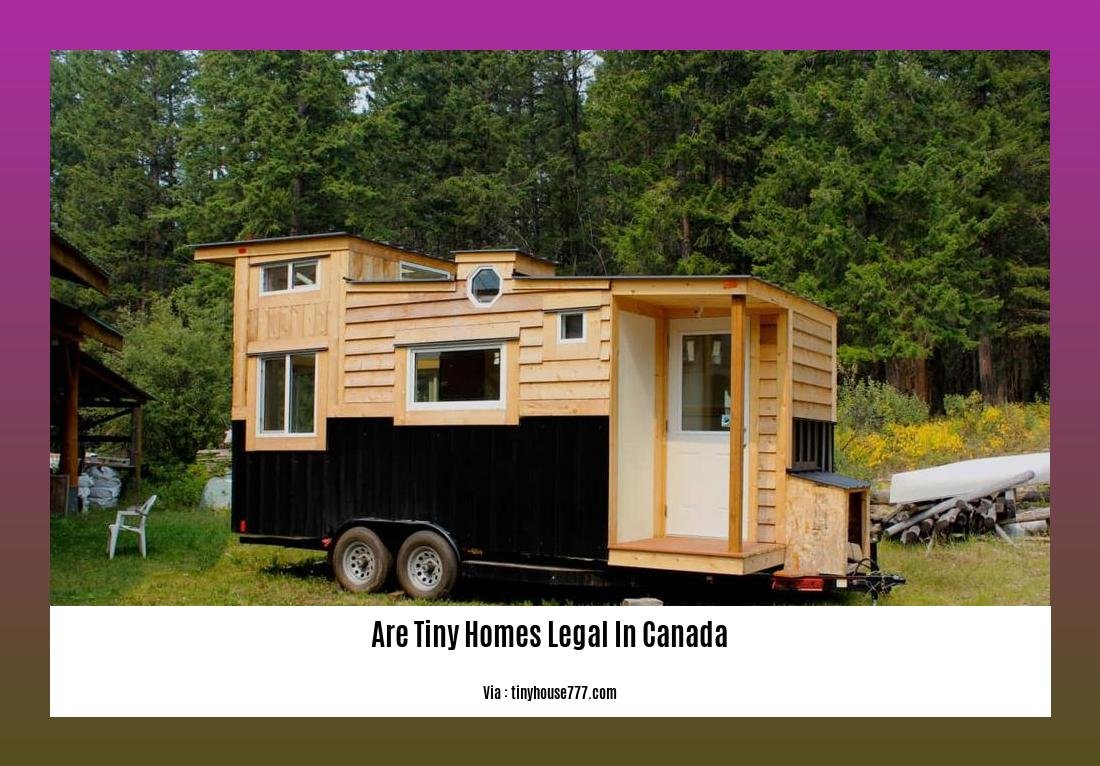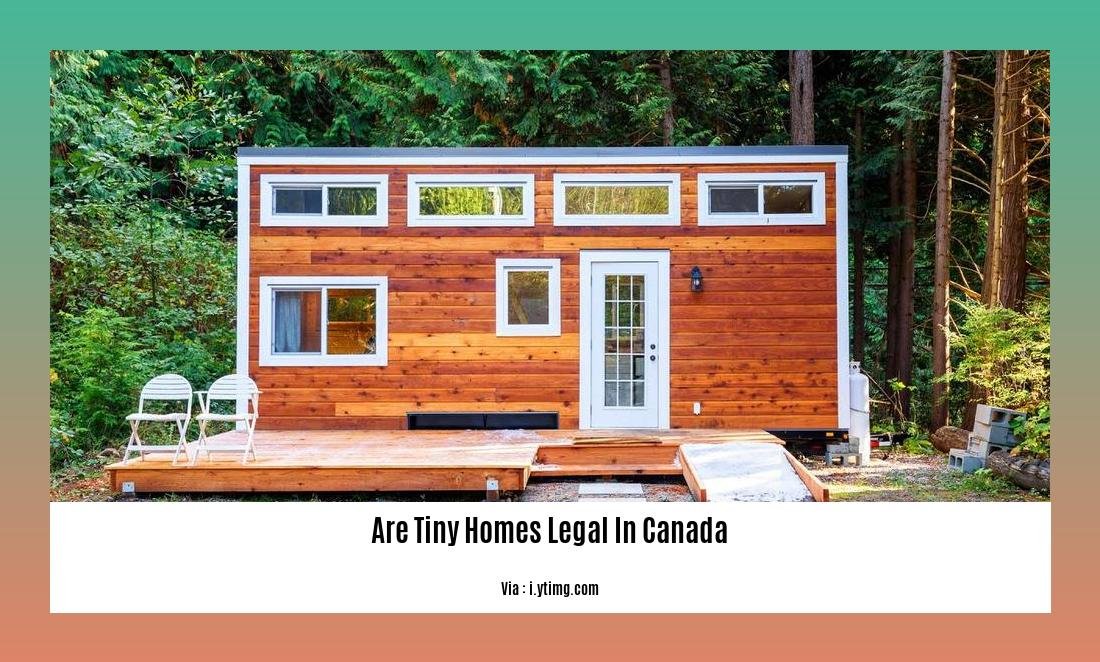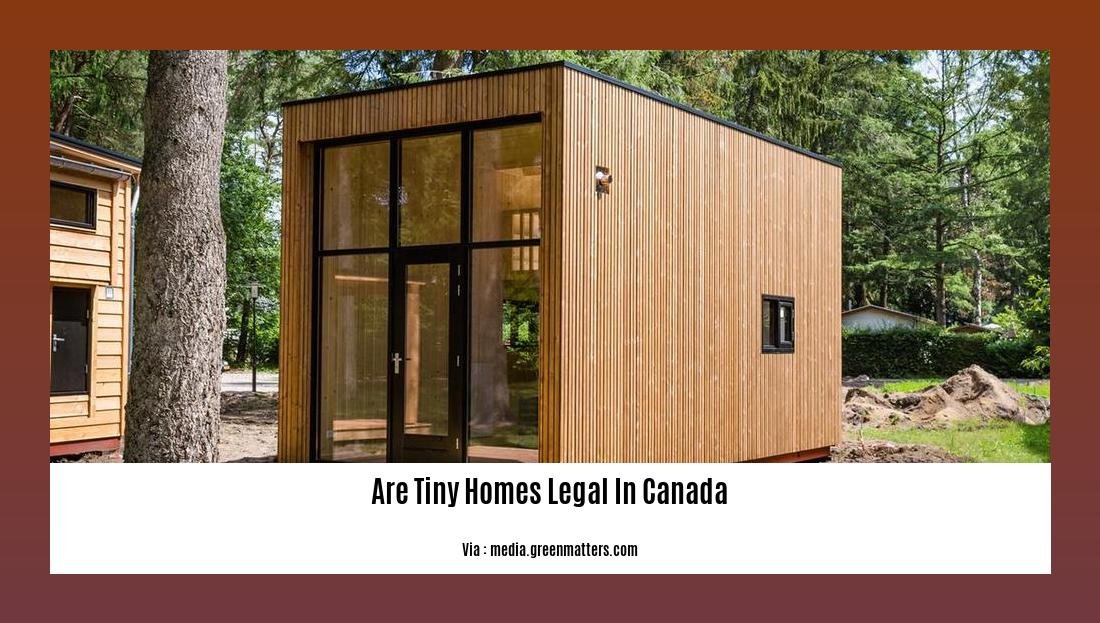Are Tiny Homes Legal in Canada? A Comprehensive Analysis of Zoning Regulations, Building Codes, and Local Bylaws
If you’ve ever dreamed of downsizing and embracing a simpler, more sustainable lifestyle, the concept of tiny homes might have caught your attention. With their efficient use of space and minimalistic design, these pint-sized dwellings have been gaining popularity worldwide. However, before you embark on your tiny home journey in Canada, it’s crucial to navigate the legal landscape. Zoning regulations, building codes, and local bylaws play a significant role in determining the feasibility and legality of tiny homes in various Canadian provinces. In this comprehensive analysis, we will delve into the intricacies of Canadian real estate law and the specific regulations that govern these unique abodes. So, let’s explore the question on every aspiring tiny homeowner’s mind: are tiny homes legal in Canada?
Key Takeaways:
- Canada allows tiny houses, as there are no national regulations governing their size.
- Building codes for tiny houses vary from province to province, so it is necessary to check with the local municipality for any restrictions.
- More and more municipalities in Canada are accepting houses of less than 700 square feet, but they must be installed in designated areas.
- In Ontario, a building permit is required for a tiny house to ensure compliance with the Ontario Building Code and municipal by-laws.
- Quebec supports the legal use of tiny houses on wheels as motorized vehicles, offering more freedom to owners.
- Tiny houses have been proposed as a government-approved solution to Ontario’s housing crisis.
- The legality of tiny homes in Canada depends on different regulations and bylaws specific to each province and municipality.
Are Tiny Homes Legal in Canada?

Overview
Tiny homes have gained popularity in recent years as a more affordable and sustainable housing option. However, many people are still unsure about the legalities surrounding these compact dwellings. In Canada, the legality of tiny homes varies depending on the province and municipality. Before embarking on your tiny home journey, it is crucial to understand the zoning regulations, building codes, and local bylaws that apply to your specific area. In this article, we will provide a comprehensive analysis of the legal landscape surrounding tiny homes in Canada.
Zoning Regulations and Building Codes
One of the key factors that determine the legality of tiny homes in Canada is zoning regulations. Zoning regulations are rules that govern land use and determine what types of structures can be built in specific areas. These regulations are set by local municipalities and can vary greatly from one location to another.
In general, most municipalities in Canada allow tiny homes, but there may be restrictions on where they can be placed. Some areas have designated zones for smaller dwellings, while others require tiny homes to be installed in existing residential zones. It is essential to consult with the local municipality to understand the specific zoning regulations and obtain any required permits.
Aside from zoning regulations, building codes also play a crucial role in the legality of tiny homes. Building codes are regulations that specify the minimum standards for construction and safety. They cover various aspects such as structural integrity, electrical systems, plumbing, and insulation. Adhering to building codes ensures that the tiny home meets the necessary requirements for safe habitation.
Building codes for tiny homes vary across provinces in Canada. For example, in Ontario, a building permit is required for a tiny house to ensure compliance with the Ontario Building Code and municipal bylaws. On the other hand, Quebec treats tiny houses on wheels as motorized vehicles, offering owners more freedom in terms of where they can be located.
Advantages of Tiny Homes
Tiny homes offer several advantages for those considering downsizing or seeking an alternative housing solution. Some benefits of tiny homes include:
- Affordability: Tiny homes are generally more affordable than traditional houses, making homeownership more accessible for many individuals.
- Sustainability: These compact dwellings often have a smaller carbon footprint due to their reduced energy consumption and use of eco-friendly materials.
- Mobility: Some tiny homes are built on wheels, offering the flexibility to move and explore different locations without the need for a permanent foundation.
- Minimalism: Tiny homes promote a minimalist lifestyle, encouraging individuals to declutter and live with fewer possessions.
Challenges and Considerations
While tiny homes offer many advantages, there are also challenges and considerations to keep in mind. Some key factors include:
- Zoning Restrictions: As mentioned earlier, zoning regulations can limit where tiny homes can be placed. It is crucial to research and understand the zoning regulations specific to your desired location.
- Limited Space: Tiny homes are designed to maximize space efficiency, but this can still present challenges in terms of storage, living arrangements, and meeting basic needs.
- Financing and Insurance: Securing financing for tiny homes can be more challenging than traditional homes. Additionally, finding insurance coverage tailored to the unique features of a tiny home may require some research and negotiation.
Conclusion
In conclusion, the legality of tiny homes in Canada is dependent on various regulations and bylaws specific to each province and municipality. Understanding the zoning regulations, building codes, and local bylaws that apply to your area is crucial before embarking on a tiny home project. Although it may require some additional research and due diligence, the growing acceptance of tiny homes in Canada offers exciting possibilities for affordable, sustainable, and flexible housing options. So, if you’re considering living the tiny home dream, make sure to navigate the legal intricacies and consult with local authorities to ensure compliance with all applicable regulations.
Are tiny homes legal? Find out more about the legalities of tiny homes and their regulations by clicking here.
Curious about the legality of tiny homes in New Brunswick? Discover the answer and learn about the regulations by clicking here.
Thinking about building a tiny home in Ontario? Explore the process and requirements by clicking here.
Wondering if you can build a tiny home in Ontario? Get all the information you need by clicking here.
Interested in building a tiny house in Ontario? Learn about the regulations and considerations by clicking here.
Exploration of Building Codes and Regulations that May Affect Tiny Home Construction

Tiny homes have become increasingly popular as a minimalist and sustainable housing option in Canada. However, before embarking on the construction of a tiny home, it is important to understand the building codes and regulations that may apply. In this article, we will explore the key points regarding building codes for tiny houses and provide relevant sources for further information.
Significance of Tiny Home Building Codes
Building codes for tiny houses play a crucial role in ensuring the safety and well-being of both the occupants and the surrounding community. These codes establish minimum standards and guidelines for construction and placement of tiny homes.
(Source: Building Code Trainer)
Compliance with Building Regulations and Zoning Laws
Tiny houses must comply with building regulations and zoning laws set by local authorities. It is essential to research and understand the specific requirements applicable to your location as these may vary depending on the region and municipality.
(Source: Home Upgrade Place)
Ontario’s Building Code for Tiny Homes
In Ontario, Canada, tiny homes are subject to the regulations outlined in the Ontario Building Code. This code applies to both on-site built and factory-built tiny homes. Construction or placement of a tiny home in Ontario requires a building permit.
(Source: Ontario)
Municipal Zoning Bylaws and Development Charges
Municipal zoning bylaws and development charges may have implications for tiny houses. These regulations cover aspects such as land use, density, setbacks, and property taxes. It is important to note that zoning regulations for tiny houses on wheels (THOWs) are still being developed in many areas.
(Source: Tiny Houses in Canada’s Regulatory Context)
Tiny Home Building Standards
The Tiny Home Industry Association advocates for building standards tailored to the tiny home industry. These standards aim to ensure the quality and safety of tiny homes. However, it is important to note that there is currently no universally accepted national building code specifically for tiny houses.
(Source: Tiny Home Industry Association)
Alternative Building Standards
In some cases, it may be possible to seek approval for a tiny home project under alternative building standards. For example, the International Residential Code (IRC) Appendix Q for Tiny Houses provides guidelines for tiny homes that meet specific criteria.
(Source: Mini Green Home)
It is crucial to research and consult with local authorities and professionals to ensure compliance with the relevant building codes and regulations in your specific region. By understanding and adhering to these codes, you can confidently move forward with the safe and legal construction of your tiny home.
Key Takeaways:
- Building codes for tiny houses are essential in ensuring the safety and well-being of occupants and the community.
- Compliance with building regulations and zoning laws set by local authorities is crucial for tiny home construction.
- In Ontario, Canada, tiny homes must adhere to the regulations outlined in the Ontario Building Code and require a building permit.
- Municipal zoning bylaws and development charges may impact the placement and construction of tiny houses.
- The Tiny Home Industry Association promotes building standards specific to the tiny home industry, but there is no universally accepted national building code for tiny houses.
- Alternative building standards, such as the International Residential Code Appendix Q, may offer guidelines for tiny homes meeting specific criteria.
Sources:
– Building Code Trainer
– Home Upgrade Place
Discussion of Challenges and Obstacles Faced by Those Wanting to Live in Tiny Homes in Canada
The tiny home movement has gained significant popularity in recent years as a sustainable and affordable housing alternative. However, there are several challenges and obstacles that individuals face when wanting to live in tiny homes in Canada. Let’s explore these challenges and discuss potential solutions.
1. Access to Land
One of the biggest challenges for those interested in tiny homes is finding suitable land to place them. Land is often expensive and limited, especially in areas close to city or town centers where people may desire to be for easy access to services, entertainment, and employment opportunities. The high demand for such locations can create a conflict, as land closer to the city tends to be more costly.
2. Legal and Regulatory Issues
Navigating the legal and regulatory landscape is another significant obstacle for tiny home enthusiasts. The legality of tiny homes varies depending on the province and municipality. While some provinces like Ontario see tiny homes as a potential solution to the housing crisis, others have stricter regulations. For instance, the National Building Code of Canada states that tiny homes cannot be used as permanent residences if they do not meet the minimum size requirements.
3. Social Pressures and Stigma
Social pressures can also present challenges to the tiny house movement. Some individuals may carry stigmas associated with living in a tiny home, perceiving them as less desirable or prestigious compared to larger, more traditional homes. Overcoming these social pressures and educating others about the benefits and values of tiny homes can help alleviate these challenges.
4. Fear of the Unknown
Fear is another significant barrier that individuals face when considering tiny home living. The idea of living in a smaller space and making significant lifestyle adjustments can be daunting for some. However, with proper planning and understanding of the benefits and possibilities that come with tiny homes, individuals can overcome their fears and embrace this lifestyle.
In conclusion, the desire to live in tiny homes in Canada comes with its share of challenges and obstacles. Access to land, legal and regulatory issues, social pressures, and fear are among the key barriers that individuals may encounter. However, it is important to recognize that despite these challenges, the appeal of smaller, more cost-effective homes persists. By addressing these obstacles through effective advocacy, community engagement, and comprehensive research, the dream of living in a tiny home can become a reality.
Key Takeaways:
- Access to suitable land is a significant challenge for those interested in living in tiny homes in Canada, especially in areas close to city or town centers.
- The legality of tiny homes varies depending on the province and municipality, and regulations such as building codes may pose obstacles.
- Social pressures and stigmas associated with tiny home living can also present challenges that need to be addressed.
- Fear of the unknown and concerns about lifestyle adjustments are common obstacles that individuals face when considering tiny home living.
- By advocating for tiny home regulations, educating others about their benefits, and conducting thorough research, these challenges can be overcome.
Summary of Current Legal Landscape and Potential Future Developments for Tiny Homes in Canada
The current legal landscape for tiny homes in Canada is complex and varies depending on the province and municipality. Zoning regulations, building codes, and local bylaws all play a crucial role in determining the legality of tiny homes. Despite the challenges and uncertainties, there is a growing acceptance of tiny homes as a viable housing option in Canada.
Challenges and Issues Surrounding Tiny Homes
-
Regulatory Context: Tiny homes that do not fit into the current regulatory context may not be allowed in certain areas. It is essential to be aware of the regulations in place before considering building or living in a tiny home.
-
Interpretation and Application: The interpretation and application of current requirements regarding tiny homes can vary, creating confusion and uncertainty. Addressing this aspect is crucial for better clarity and consistency.
-
Zoning Bylaws: Zoning bylaws can inadvertently create obstacles for tiny homes. Careful consideration and review of zoning regulations are needed to accommodate this housing option.
Potential Future Developments
-
Acceptance by Municipalities: Municipalities throughout Canada are gradually accepting houses of less than 700 square feet. However, they may require these homes to be installed in designated neighborhoods or stretches of land dedicated exclusively to them to be considered legal.
-
Land-lease or Condominium/Strata Villages: The development of land-lease or condominium/strata villages or parks can provide opportunities for municipalities to increase revenue while accommodating tiny homes. Certain dimensions and weight limits may not require permits for moving the homes.
-
Rising Housing Costs: Rising housing costs and reduced rental housing stock have prompted some local governments in British Columbia to consider tiny homes as a year-round housing option.
-
Consideration of Regulations: Municipal zoning bylaws, development charges, and property taxes have implications for tiny houses and need to be carefully considered. Currently, site-built tiny houses on wheels fall outside the existing regulatory framework.
Key Takeaways:
- The legal landscape for tiny homes in Canada is complex and varies across provinces and municipalities.
- Zoning regulations, building codes, and local bylaws play a crucial role in determining the legality of tiny homes.
- Challenges include fitting tiny homes into the current regulatory context, inconsistent interpretation and application of requirements, and obstacles created by zoning bylaws.
- Potential future developments include the gradual acceptance of smaller houses, the development of specialized villages or parks, consideration of tiny homes as a housing option, and careful examination of existing regulations and framework.
- It is crucial for individuals interested in tiny homes to research and understand the specific regulations and bylaws for their desired location.
Source 1
Source 2
FAQ
Q1: Are tiny homes legal in Canada?
A1: The legality of tiny homes in Canada depends on different regulations and bylaws specific to each province and municipality. While there are no national regulations governing their size, building codes for tiny houses vary from province to province. It is necessary to check with the local municipality for any restrictions and ensure compliance with the Ontario Building Code and municipal by-laws in Ontario.
Q2: What are the building code requirements for tiny houses in Canada?
A2: Building codes for tiny houses serve to establish minimum standards and guidelines for construction and placement. Tiny houses must comply with building regulations and zoning laws set by local authorities. These regulations may vary depending on the region and municipality. In Ontario, Canada, tiny homes are required to meet the regulations outlined in the Ontario Building Code, and a building permit is necessary for construction or placement.
Q3: Can tiny houses be used as permanent residences in Canada?
A3: The National Building Code of Canada states that tiny homes cannot be used as permanent residences if they do not meet the minimum size requirements. However, more and more municipalities in Canada are accepting houses of less than 700 square feet, but they must be installed in designated areas or neighborhoods dedicated exclusively to them to be legal.
Q4: What are the challenges to the tiny house movement in Canada?
A4: The tiny house movement in Canada faces various challenges, including access to land, legal and regulatory issues, social pressures, and fear. Land is expensive and in short supply, creating a barrier for those wanting to live in a tiny house. The legality of tiny homes varies depending on location, and there may be stigmas associated with living in a tiny home. Additionally, people may fear the unknown and the lifestyle changes that come with living in a smaller space.
Q5: Is there a nationally accepted building code for tiny houses in Canada?
A5: Currently, there is no universally accepted national building code specifically for tiny houses in Canada. However, the Tiny Home Industry Association advocates for building standards specific to the tiny home industry to ensure the quality and safety of tiny homes. In some cases, it may be possible to seek approval for a tiny home project under alternative building standards such as the International Residential Code Appendix Q for Tiny Houses.
- Doubling 1/3 Cup: Quick Answer and Easy Kitchen Conversions - March 22, 2025
- J Middleton Unit (Abilene, TX): Inmate Search, Visitation, and Contact Information - March 22, 2025
- Ivermectin Dosage for Dogs: A Weight-Based Guide - March 22, 2025










